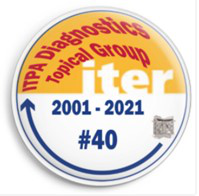Speaker
Description
Between the various compact diagnostics systems, the hybrid CMOS-based and gas electron multiplier (GEM) detectors of multiple sizes, types, and combinations can offer a real “swiss-knife” solution for the experimental investigation of ionizing radiation. They were used, for many years, by the LabNIXT group of ENEA Frascati on many experimental setups (FTU, KSTAR, EAST, VEGA, GEKKO, etc.). In particular, the hybrid detectors based on silicon or other semiconductors are realized with a single or multiple chips bump-bonded with a semiconductor layer. Interaction of ionizing radiation in this configuration produces some characteristic tracks inside the detector. The produced charge is collected and recorded as a cluster of pixels. For each cluster, a variety of physical and morphological parameters can be defined. These detectors can be used, with different settings, to discriminate alpha, beta, gammas, hard-X, and neutrons. The hybrid detectors can be coated with one (or more) layers of converter material to observe thermal neutrons. Moreover, by combining chemical-vapor-deposited diamond and the hybrid detectors’ ASIC, a fast neutron measurement is also possible in harsh environments. The triple GEM detector is an outstanding candidate for detecting plasma volumes emitting X-ray photons in the 2-30 keV energy range, thanks to its high dynamic range, sensitivity, high rate, energy resolution, and noise-free detection. The GEM camera system is a micropattern proportional gas detector that consists of an ionization gap. X-ray photon conversion occurs, three consecutive foils that act as an amplification stage, and finally, a dedicated printed circuit board that can be easily mounted outside the port of a fusion machine. A hybrid GEM detector that couples the GEM versatility and the hybrid detectors compactness (GEMPix) can be proficiently used in all the experimental situations where higher spatial resolution is required, keeping the intrinsic gain. GEMpix has been positively tested also for 2-D imaging of laser produced plasma in VEGA (Spain) and Gekko XII (Japan) Laser Facilities
KEYWORDS: Detector design and construction technologies and materials; Micropattern gaseous detectors; Nuclear instruments and methods for hot plasma diagnostics; Hybrid pixel detectors, Neutron detectors, GEM, GEMpix, Timepix

